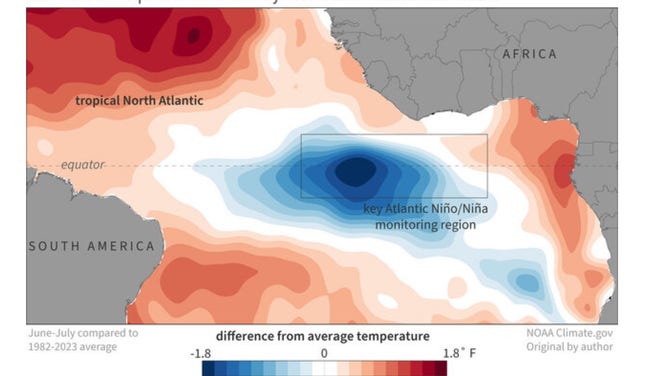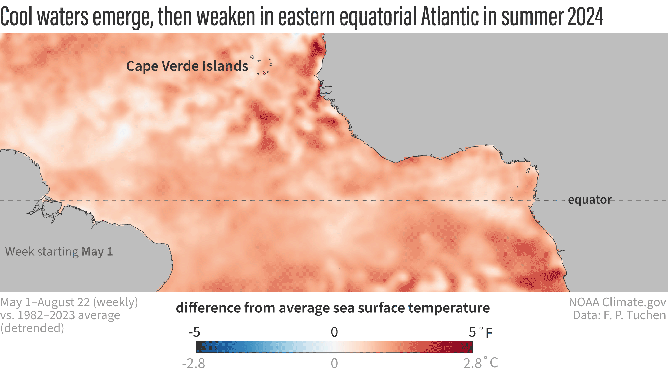Is there a weather phenomenon known as the Atlantic Nina?
Atlantic Niños and Niñas likely impact western Africa, but their effects outside the continent remain poorly understood. Researchers have suggested that there could be impacts on the Atlantic basin hurricane season and other countries bordering the ocean.
NOAA declares El Nino climate pattern dead with flip to La Nina likely
The strong El Niño pattern that had a significant influence on major weather pattern shifts over the past year has come to an end, NOAA announced in its monthly update Thursday.
For more than half a century, terms such as El Niño and La Niña have been used to describe climate patterns based on Pacific Ocean water temperatures. However, there is increasing attention paid to whether a similar phenomenon occurs in the eastern Atlantic Ocean.
Only within the last couple of decades have climatologists started using terms like ‘Atlantic Niño’ and ‘Atlantic Niña’ to describe cooler or warmer water temperatures off western Africa.
Similar to the Pacific, the region is located along the equator and is bordered on its eastern end by a significant landmass, but that is where the similarities mostly end.
Climate patterns along the western coastline of the African continent are undoubtedly impacted by the varying water temperatures, but how the ocean affects the broader Atlantic basin, including South America and even the U.S. remains relatively unknown.
Most recently, the significant cooling of the eastern Atlantic during the summer of 2024 has provided scientists with an opportunity to analyze and determine if an Atlantic Niña formed and what its implications might be.
NOAA satellite data indicated that waters south of Liberia, along the equator, reached one degree Celsius below normal during June and July, creating a blue blob in what was otherwise a sea of red, warmer waters.

Cool waters in the eastern Atlantic Ocean
(NOAA)
"Our plan was to wait give the August data a chance to come in and be analyzed before doing a follow-up post in early or mid-September covering whether the event formed or fizzled, what the potential influences could be on seasonal temperature and precipitation in the region, as well as some background on what we know and don’t know about why these events occur and whether human-caused climate change is expected to affect the pattern," NOAA climate scientists stated.
Since there is less scientific data for these episodes, there is not as stringent criteria for the event as there is with an El Niño, La Niña or La Nada pattern in the Pacific.
LITTLE-KNOWN WEATHER PATTERN WHEN EL NINO AND LA NINA ARE NO LONGER IN CONTROL
Generally speaking, an event that lasts for three months or longer with water temperature anomalies above +0.5 degrees Celsius is considered an Atlantic Niño, while temperatures cooler than -0.5 degrees Celsius result in an Atlantic Niña.
The occurrence of the Atlantic Niña and Atlantic Niño are less frequent when compared to their Pacific counterparts, with each happening only about half a dozen times since the early 1980s.
It is also rare for similar conditions of below or above-water temperatures to develop simultaneously in both the Atlantic and Pacific.
For example, if a La Niña was present in the Pacific, it would be unusual to see an Atlantic Niña develop at the same time.
The most common scenario is for the Atlantic to experience extreme conditions of either an Atlantic Niño or Niña during periods of neutral stage of the El Niño Southern Oscillation in the Pacific.

Cool waters in the eastern Atlantic Ocean
(NOAA)
WHAT ARE EL NINO AND LA NINA CLIMATE PATTERNS?
Implications for the 2024 hurricane season?
Some forecasters have cited the emergence of an Atlantic Niña as being one of the primary drivers for a relatively inactive hurricane season, when compared to seasonal outlooks.
The cooler sea surface temperatures can lead to a reduction in the amount of moisture needed for developing cyclones, especially in the eastern Main Development Region.
Without pristine conditions in the MDR, tropical waves that splash down off the coast of western Africa take longer to develop and, in some cases, can never completely recover from the influence of dry air.
The impact of an Atlantic Niña on hurricane activity is not yet well enough understood for agencies to quantify how much impact there is on the season.
"…during the past several years multiple studies have also suggested that the impact of Atlantic Niño and Niña can reach far beyond the equatorial Atlantic, potentially influencing the development of hurricanes near the West African coast and possibly even El Niño and La Niña in the Pacific! But, not all scientists are on board with the new, global-impacts hypotheses. So, we need to let the science evolve to see if those hypotheses mature into ‘knowledge,’ " NOAA experts recently stated in a climate blog.

Example map of the Main Development Region of the North Atlantic Ocean
(FOX Weather)
